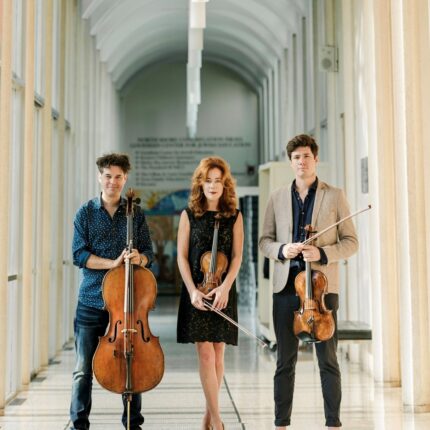Worthy new music by Chicago composers receives uneven advocacy at Epiphany

The Chicago Composers’ Consortium wrapped its concert season at the Epiphany Center for the Arts on Thursday evening in typical form with a bevy of new works by its core members.
On the bill was the Black Oak Ensemble — violinist Desirée Ruhstrat, violist Aurélien Fort Pederzoli, and cellist David Cunliffe — who engaged venerable flutist and new-music maven Mary Stolper for the occasion. This auspicious pairing of performers, however, yielded markedly uneven results.
The Epiphany Center’s sanctuary, an intimate chapel clad in dark wood, was a fitting venue for the evening’s salon-like tenor. Each of the evening’s composers, except for one, introduced their works — most of which were being heard in their first performances.
One such exception on both accounts was Shulamit Ran’s East Wind, a solo flute caprice that evokes alternately violent and voluptuous character of the eponymous biblical gale. Stolper—who has been a champion of the work since its premiere in 1989—masterfully delivered both improvisatory gentleness and athletic vigor, maintaining pure tone even in the piece’s most witheringly virtuosic declamations.

The Black Oak Ensemble demonstrated their bona fides in Laura Schwendinger’s una brevissima canzone senza parole, a short work adapted from her string quartet una breve canzone senza parole. The trio upholstered the piece’s melancholic clusters chords with velvet sonority, making sensitive adjustments in timbral character as Pederzoli’s mournful viola incantations emerged and re-submerged into the texture.
Only when the string trio reassembled with Stolper for two movements of Timothy Dwight Edwards’ Will o’ the Wisp, did the ensemble’s fissures start to emerge. Stolper was assured in the ethereal, somersaulting theme of the prelude, “Lore,” though the string players soon overwhelmed the flute in volume. Even as the overall balance righted itself, disagreements in tempo soon arose. During the third-movement canon fugue, the asymmetrical fugal subject was delivered with a sense of uncertainty that spread throughout the ensemble as the melody passed among the musicians.
The string players, sans Stolper, fared better in Martha Horst’s Elegiac Gestures, a subtly affecting work that delivers harmonic transformation through half-step shifts. The score’s contrapuntal nature and slower tempo primed the canvas for Black Oak’s fabulously warm and burnished sound, yet revealed some new issues. In the piece’s middle section, the harmonic panorama of all three instruments delivering double stops was soured by intonation issues.
Stolper once again demonstrated poise and sensitivity in the alto flute solo Velvet Moon by Kathleen Ginther. Where East Wind embraced daring—even violent—gestures, Velvet Moon maintained understatement throughout its duration. The flutist’s rich tone and finely calibrated pacing cast a spell over the room, and she held narrative interest even when the new-music vernacular of key clicks, whistle tones and timbral trills began to grow repetitive toward the work’s end.
Amos Gillespie’s Surrounding Elements for string trio was one of the more conceptually and harmonically transparent, and thus ably performed, works on the program, in addition to being the only other non-premiere of the evening. Inspired by Frank Lloyd Wright’s Emil Bach House in Rogers Park, the work bookends an expansive, Copland-esque central passage with a pair of lyrical, pastoral duets, meant to suggest the tranquil natural setting that frames the house’s elegant mid-century architecture.
The strings found their footing at last as they reconvened with Stolper for the closing work, Elizabeth Start’s Nostalgia, which casts three forms of vernacular music from the Americas—ragtime, the blues, and tango—in a cheeky setting.
The first movement, “Rag Tag Too,” staged a game of tag as the players chased syncopated melodies around the ensemble. This is fun music, though not all the musicians seemed to be in on the joke; the string players seemed glued to their music, and even swooping glissandi and other more jocular gestures were delivered stiffly and perfunctorily.
Stolper and violinist Desirée Ruhstrat delivered some of the evening’s more convincing performances in the second movement, “True Blue Too,” as each sought to outdo the other’s throaty declamations inflected with schmaltzy vibrato and sticky glissandi before finally melding in a glassy duet.
The final movement, “Tangled Tango Too,” despite a somewhat stuffy groove, was handled adeptly enough. Yet while these are fine musicians and this was a worthy occasion, the somewhat lackluster finale to the evening left one wondering what could have come with a spot of polish—and more rehearsal.
The chamber music series at Epiphany Center for the Arts continues this weekend with performances by Lynx Project and ~Nois. epiphanychi.com
Posted in Performances


